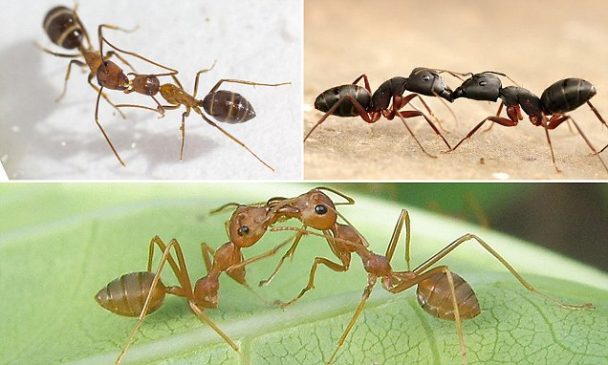Ants have social networks, and they exchange info through vomit.

Ants have social networks just like humans do, but instead of exchanging information through posts and comments, they vomit into each other’s mouths.
Most insects have a foregut, a midgut and a hindgut. “However, for social insects, the foregut has become sort of a ‘social stomach,'” said Adria LeBoeuf, an assistant professor and leader of the Laboratory of Social Fluids at the University of Fribourg in Switzerland. Contents of the midgut and hindgut are digested, while contents of the foregut are meant to be shared, said LeBoeuf, lead author of a new study describing the findings.
Trophallaxis, or the act of regurgitating food into another organism’s mouth, is very common in highly social species like ants. During a trophallaxis event, nutrients and proteins are passed from one individual”s social stomach to another’s, and through a series of these exchanges, the ants create a “social circulatory system” that connects each member of the colony to everyone else, LeBoeuf said.
Carpenter ants (Camponotus) constantly pass these nutrients to one another in this way. If you look at one colony, in a single minute you might see “20 trophallaxis events,” LeBoeuf told Live Science. (An ant colony might hold at least thousands of ants.)
“About five years ago, we published a paper characterizing the fact that when ants do trophallaxis, they aren’t just passing external food,” LeBoeuf said, referring to a 2016 report in the journal eLife. “They are passing out hormones, nestmate recognition cues, small RNAs and all sorts of other things.”
So, by vomiting into each other’s mouths, ants aren’t simply exchanging nutrients, the study authors wrote. Instead, the ants are creating a digestive social network in which energy and information circulate constantly throughout the colony to be collected by the individuals that need these resources. This is much like how your brain can secrete a hormone and pass it to your circulatory system and it will eventually reach your liver.
Lebouf thinks of a colony of ants not as a collection of individual ants, but instead as a “colonial superorganism,” where the colony essentially functions as if it were a body. Much like how a body has tissues and organs that perform jobs in support of a common goal, groups of ants with different jobs can be thought of as the tissues and organs of the superorganism. The foragers gather food, the nurses take care of young, the workers dig tunnels, etc. Organs use the circulatory system to pass around much more than food, so is it possible that the social circulatory system does more as well?
“To help us understand why ants share these fluids, we explored whether the proteins they exchange are linked to an individual’s role in the colony or the colony’s life cycle,” lead author Sanja Hakala, a postdoctoral fellow at the University of Fribourg, said in a statement.
For their most recent experiment, LeBoeuf and Hakala analyzed the social stomach contents of carpenter ants in both wild colonies and lab-raised colonies. Across their samples, they identified 519 proteins being passed around the ant colonies; 27 of those proteins were found in all of their samples, regardless of the colony’s age, the colony’s location or the individual ant’s status.
The workers seem to be foraging for food, building that food into specific proteins and then passing those proteins around, LeBoeuf said. As a colony matures, more nutrient storage proteins — which act as a very concentrated food source — enter circulation, so older colonies have more of these proteins overall than younger colonies do, the team found.
“Often, adults in ant colonies don’t even need to eat,” LeBoeuf told Live Science. “Instead, they sort of slowly break down these nutrient-storing proteins.”
Many adults in the colony don’t have to eat because there are ants that eat on behalf of the colony.
“These findings show that some colony members can do metabolic labour for the benefit of others,” Hakala said in a statement.
By analyzing what proteins were found where, LeBoeuf and colleagues could tell the difference between young and mature colonies, as well as differentiate wild and lab-raised colonies. which had a much lower diversity of proteins in their social stomachs than their wild counterparts.
The role an individual ant plays in the colony can be determined by its social stomach contents, too, the team found. So-called nurse ants that care for young tended to have higher amounts of anti-aging proteins than other members of the colony, potentially to ensure that they survive to care for future generations.
“We know now that things are produced in certain individuals, and they end up in other individuals, which is super exciting,” LeBoeuf said. However, there are still many questions left to answer, she said. For instance, the team found that foragers had higher concentrations of nutrient storage proteins than nurses did but that nurses produced those proteins faster. The researchers aren’t sure why this is.
LeBoeuf thinks studying systems like nutrient exchange in ants may help scientists better understand how metabolic labor is divided within individual organisms, as in, between the cells that make up a body. “It is hard to measure how metabolic work is shared between cells,” LeBoeuf said. “Here, the ants pass things around in a way that we can easily access what they are sharing.”
